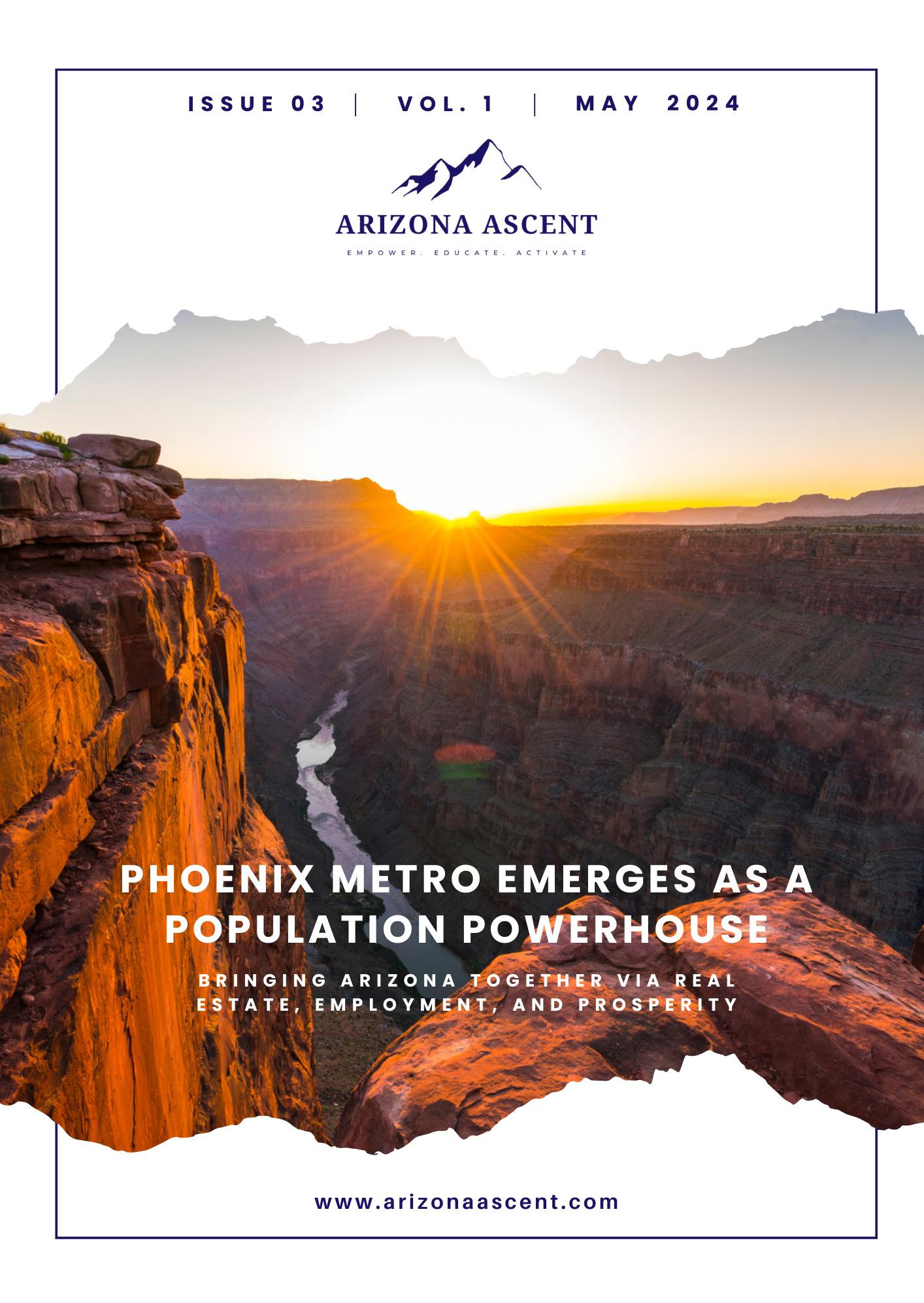
briefing on the latest trends igniting the Phoenix Real Estate Market.

The Phoenix Metro's Sizzling Housing Market and Soaring Population Growth
Phoenix's Industrial Construction Boom Fuels Red-Hot Housing Market
Striking Gold in Goodyear, Arizona: The Numbers that Captivate Investors
TABLE OF CONTENTS I. APRIL 2024 SNAPSHOT: II. REAL ESTATE HOT BRIEFS III. FEATURED ARTICLES 5 4 6 8 10 12 Phoenix Housing Market Stuck
Neutral Exclusive
-
-
Phoenix
Powerhouse
in
-
Metro Emerges as a Population

Revolutionizing Cancer Research in the Grand Canyon State: An Interview with Brenda Noggy, Founder of TrialNAV - Priced Out or Prospering? How Generation Z in Phoenix Fares in the Housing Market - Stargazing and Home Values Soar in Fountain Hills
Bringing Arizona Together Via Real Estate, Employment, and Prosperity IV. BUSINESS SPOTLIGHT: V. THANK YOU TO OUR SPONSORS III. FEATURED ARTICLES 14 16 18 19
EDITOR’S NOTE
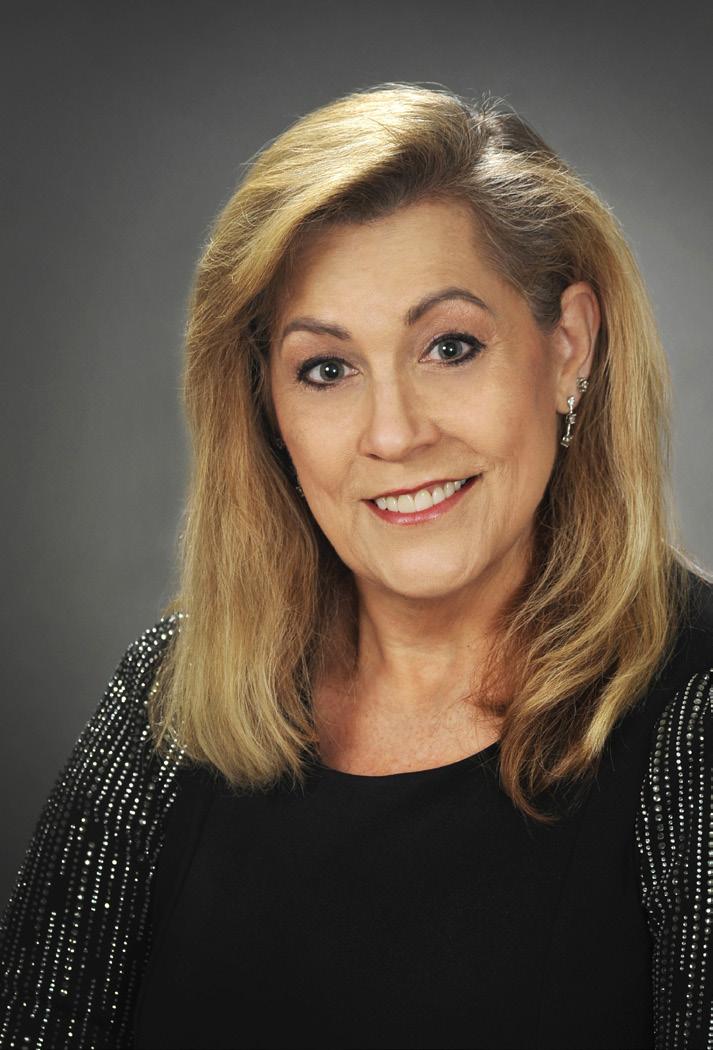
Jaki Underwood
Letter from the Editor
Dear Readers,
Welcome to the May 2024 edition of Arizona Ascent! Our mission is to illuminate and energize the thrilling dynamics of Arizona's real estate landscape. In this issue, we delve into two timely and essential topics: 'The Phoenix Metro's Sizzling Housing Market and Soaring Population Growth' and 'Phoenix's Industrial Construction Boom Fuels Red-Hot Housing Market.'
Our magazine is your gateway to a comprehensive understanding of the state's real estate landscape.
At Arizona Ascent, we are deeply committed to empowering, educating, and activating our community. Whether you're a seasoned buyer or seller interested in real estate market dynamics, we are here to serve you. We strive to deliver valuable insights, from practical tips to forecasting upcoming trends, aiming to equip you with the knowledge to navigate the ever-evolving real estate landscape confidently.
As we delve into the latest developments, it's clear that Arizona's residential real estate market is experiencing remarkable momentum. We are grateful for your continued support and for choosing to read the May 2024 edition of Arizona Ascent.
Warm regards,
Jaki Underwood
Page : 4
April 2024 Snapshot: Phoenix Housing Market Stuck
in Neutral
By Jaki Underwood
The Phoenix-area housing market is stuck in a holding pattern as we enter the spring of 2024. The latest data from the Arizona Regional Multiple Listing Service (ARMLS) shows a market that's cooled significantly from the frantic pace of the past few years.
Up, Up, and Away...But Slowly
Active home listings (excluding properties under contract) reached 17,025 as of April 1st - a 22% jump from a year earlier. Including homes in the contract process, total active listings hit 20,441, up 19% annually. However, the month-over-month increase was just 2.8%, indicating the buildup in supply is happening gradually.
Demand Dwindling
On the demand side, the news is less encouraging. Pending sales - homes under contract but not yet closed - fell 9.1% from a year ago to 5,371. This 3.5% drop from the prior month suggests waning buyer interest. The total number of homes under contract, including pending, CCBS, and UCB listings, declined 3.7% year-over-year to 8,601.
Closed sales did see a 17% increase from February to March, reaching 6,718 for the month. However, this was still down 12% from the prior March, highlighting the ongoing weakness in demand.
Prices Holding Steady
The news on pricing was all right. The median sales price reached $445,000 in April, up 6.0% from a year earlier. The average sales price per square foot also rose 6.1% annually to $294.42, a 0.4% increase from the prior month.
What's Next?
The Phoenix housing market is experiencing a slow uptick in supply, but demand remains sluggish. Price growth is holding up for now, but the decline in pending and under-contract activity suggests that more volatility may lie ahead. All eyes will be on whether mortgage rates can fall and reignite buyer enthusiasm in the coming months.
Page : 5
Real Estate Hot Briefs
Construction of LEED-Certified Camelback 303 Logistics Center Begins in Goodyear
Stevens-Leinweber Construction, in collaboration with the esteemed Brookfield Properties, has commenced construction on the Camelback 303 Logistics Center. This LEED-certified industrial development, spanning 616,100 sq ft, is a testament to Brookfield's commitment to sustainable and innovative real estate solutions. The project is in the PV303 master-planned industrial park in Goodyear, AZ.
Scheduled for completion in Q4 2024, the development will offer Class A features, including 36-ft clear heights, extensive trailer, and outdoor storage capacity. Its strategic location, with immediate access to Loop 303 and I-10 corridors, ensures excellent connectivity and potential for business growth.
Leading the project is Brookfield's Rohan A'Beckett, who said, "The true difference-maker is the capacity to support significant outdoor storage." CBRE, a renowned leasing broker, is exclusively handling the project, with SLC, a trusted general contractor, and Butler Design Group, a reputable architect, ensuring the project's quality and successful completion.
Creation Moves Ahead with Nexus Commerce Center in Tempe
Creation, a prominent Arizona commercial real estate developer, has received approval to construct a three-building, 16-acre industrial park in Tempe. This will mark the company's first industrial project in the city. Nexus Commerce Center will be a 274,000-square-foot development located on the southeast corner of Elliot Road and Hardy Drive, replacing the former Elliot Corporate Center. The project will feature state-of-the-art buildings designed and built by LGE Design Build.
"This project will appeal to a wide variety of tenants from virtually all industries and can cater to tenants as small as 15,000 square feet to as large as 100,000 square feet," said Grant Kingdon, principal at Creation. Creation has partnered with Amherst and CrossHarbor Capital Partners for financial backing, and Cushman & Wakefield will handle the leasing. Site work is scheduled to begin in October, with completion expected in the third quarter of 2025.
Nexus Commerce Center is part of Creation's broader portfolio, which includes $4.5 billion in ground-up developments across several states. The company is also active in the Phoenix metro area, with several other industrial projects underway totaling over 6.5 million square feet.
Page : 6
High-end 83 Marketplace in Peoria sells for $11.1 million
Cavan Companies, a trusted developer, has crafted a newly built Class A retail center, spanning three buildings at the corner of 83rd Avenue and Happy Valley Road. The property has attracted a lineup of reputable tenants, including Bourbon & Bones, The Stetson Social, F45 Training, and Heartland Dental, with a franchisee of Seven Brothers Burgers set to open a location here, ensuring a secure and thriving business environment.
Western Retail Advisors represented the seller, Cavan Companies, in the transaction. The 19,800-squarefoot center, strategically located to benefit from strong demographics, with over 6,000 rooftops within a 5-mile radius and 31,000 vehicles passing daily, offers a promising return on investment. The development also includes a 4.27acre Phase 2 parcel, approved for two additional buildings totaling over 21,000 square feet, which is listed for sale at $4.75 million.
Phoenix industrial market records 3rd-highest Q1 leasing activity on record
The Phoenix industrial market saw a 60% spike in leasing activity in Q1 2024, reaching 6.3 million square feet - the third highest Q1. The West Valley dominated, with large deals from Sologistics, Steelcase, and a significant e-commerce retailer, indicating a diverse mix of industries driving the market.
Despite the development pipeline contracting by 44% from its Q2 2023 peak to 30.9 million square feet and the 10.6% vacancy rate expected to rise with the completion of 31 spec buildings, the figures also signify the potential for growth and new opportunities in the Phoenix industrial market, fostering a sense of optimism.
Reassuringly, the outlook for the Phoenix industrial market remains optimistic, buoyed by the support of Intel grants, TSMC expansion, and CHIPS Act funding. Notably, JLL's Phoenix team led an impressive 60% of the market's new leasing in Q1, further solidifying the market's stability.
Page : 7
The Phoenix Metro's Sizzling Housing Market and Soaring Population Growth
By Jennifer Conrad
The sun-baked Phoenix-Mesa-Chandler metro area is cementing its status as a premier destination as hordes of new resident’s flock to the region. According to the latest U.S. Census Bureau data, the Phoenix metro ranked 4th nationally in nominal year-over-year population growth, welcoming 54,916 new residents. This 1.0% growth rate placed it 14th among all major U.S. markets with over 1 million residents, underscoring the breakneck pace of its expansion.
Cushman & Wakefield's analysis of the U.S. Census Bureau's latest data highlights vital trends affecting commercial real estate, with some notable surprises and new patterns emerging. Of note, the Phoenix-Mesa-Chandler Metro ranked No. 14 of every primary market (population over 1 million) in the U.S. with a Percentage Growth YoY of 1.0% and was No. 4 with a Nominal Growth YoY.
This explosive population influx ignites the local real estate market, putting immense pressure on home prices and rents. As of April 1st, active listings in the broader ARMLS market grew 22% year-over-year, indicating increased inventory. However, this growth was relatively modest at just 2.8% from the prior month, suggesting the market is not yet oversupplied.

Page : 8

In contrast, demand appears to be weakening, with pending and under-contract listings declining. Total monthly sales were down 12% year-over-year, though they did rise 17% from the prior month, hinting at some revival in demand, though still below normal levels.
The Phoenix real estate market prices are steadily increasing, with the median sales price up 6% year-over-year. The market is described as 'insipid', indicating stability and a predictable trajectory. This should instill confidence in investors and developers, despite the low volumes compared to historical norms.
The surge of new residents is especially fueling demand for master-planned communities in the Phoenix metro. These large-scale, amenity-rich developments cater to young families and retirees, offering a compelling blend of suburban living with easy access to the urban core.
The opportunities in this rapidly expanding market are abundant for real estate investors and developers. The surge of new arrivals to the Phoenix area is creating a high demand, presenting a promising potential for growth. It's crucial to act swiftly to capitalize on these opportunities and foster a sense of optimism.
Page : 9
Phoenix's Industrial Construction Boom Fuels RedHot Housing Market Phoenix's Industrial Construction Boom Fuels Red-Hot Housing Market
By Jaki Underwood
The sun-baked Phoenix-Mesa-Chandler metro area is cementing its status as a premier destination as hordes of new resident’s flock to the region. According to the latest U.S. Census Bureau data, the Phoenix metro ranked 4th nationally in nominal year-over-year population growth, welcoming 54,916 new residents. This 1.0% growth rate placed it 14th among all major U.S. markets with over 1 million residents, underscoring the breakneck pace of its expansion.
Cushman & Wakefield's analysis of the U.S. Census Bureau's latest data highlights vital trends affecting commercial real estate, with some notable surprises and new patterns emerging. Of note, the Phoenix-Mesa-Chandler Metro ranked No. 14 of every primary market (population over 1 million) in the U.S. with a Percentage Growth YoY of 1.0% and was No. 4 with a Nominal Growth YoY.
This explosive population influx ignites the local real estate market, putting immense pressure on home prices and rents. As of April 1st, active listings in the broader ARMLS market grew 22% year-over-year, indicating increased inventory. However, this growth was relatively modest at just 2.8% from the prior month, suggesting the market is not yet oversupplied.
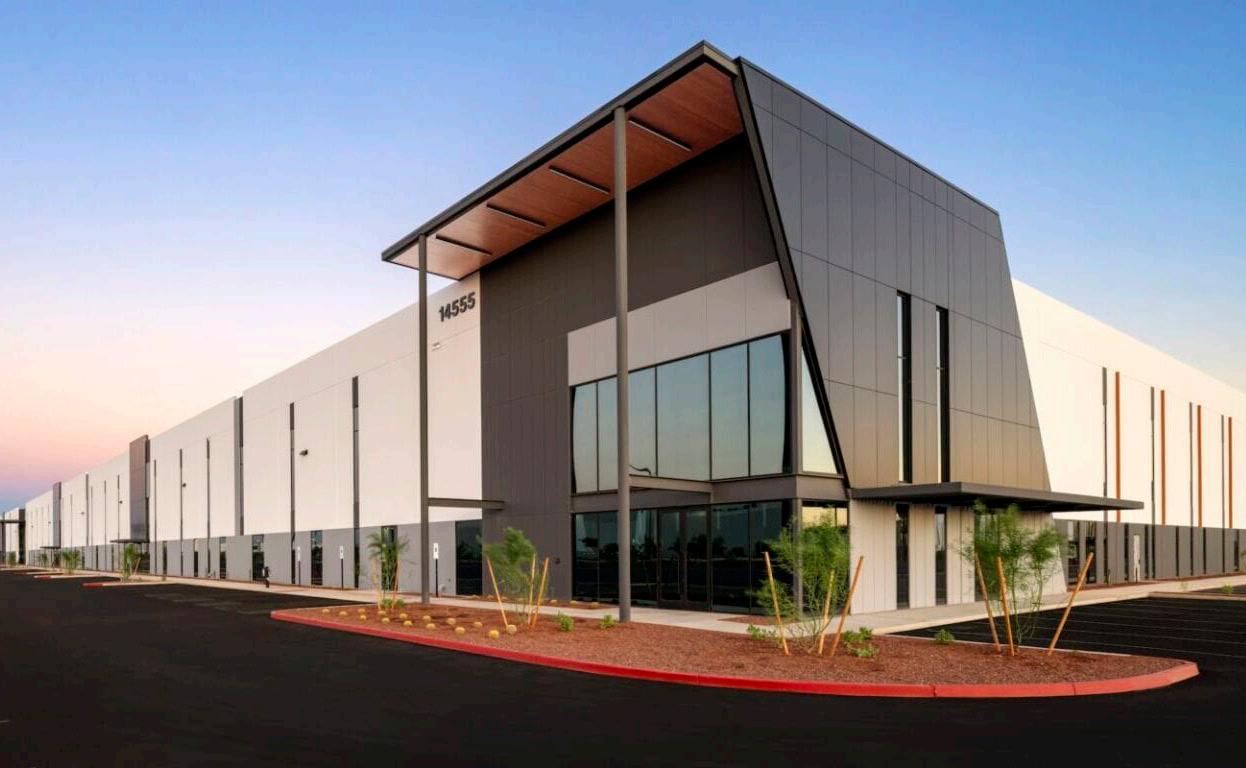
Page : 10
The latest data from the U.S. Census Bureau reveals that the Phoenix metro is ranked 4th nationally in nominal year-over-year population growth, welcoming an impressive 54,916 new residents. As hordes of new arrivals flock to the region, the demand for housing has soared, putting immense pressure on home prices and rents. The metro's 1.0% year-overyear percentage growth rate placed it 14th among all major U.S. markets with over 1 million residents, underscoring the breakneck pace of its expansion.
However, a recent market snapshot from the beginning of April 2024 shows signs of a potential shift. While active listings have increased by 22% year-over-year to 17,025, pending and under-contract listings have declined by 3.5% and 1.1%, respectively, compared to the previous month. Monthly sales have decreased by 12% compared to last year, with 6,718 sales. Despite these indicators of cooling demand, the average sales price per square foot has risen by 6.1% to $294.42.
Market Summary for the Beginning of April:
- Active Listings (excluding UCB & CCBS): 17,025 versus 13,933 last year - up 22%
- Pending Listings: 5,371 versus 5,701 last year - down 9.1%
- Under Contract Listings: 8,601 versus 8,935 last year - down 3.7%
- Monthly Sales: 6,718 versus 7,598 last year - down 12%
- Monthly Average Sales Price per Sq. Ft.: $294.42 versus $277.59 last year - up 6.1%
- Monthly Median Sales Price: $445,000 versus $419,900 last year - up 6.0%
The construction boom extends beyond industrial projects. Despite a slowdown in office construction towards the end of 2022, investment in the sector has surged, positioning Phoenix among the top markets for office real estate nationally. As of last November, Phoenix had a staggering 1 million square feet of office space under construction, a clear sign of the city's potential for growth and development.
These encouraging trends in the construction industry persist despite some ongoing challenges. Material costs remain high, and while supply chain disruptions are improving, they still pose obstacles for many projects. However, industry experts maintain a cautious optimism, foreseeing continued stability in 2024 as the Federal Reserve contemplates halting interest rate hikes, potentially further boosting construction activity.
Phoenix's unstoppable construction pipeline stands in stark contrast to the pause in the rest of the country's real estate market. This success story is a testament to the region's enduring allure as a business and investment hub, propelling explosive growth across commercial and residential sectors. However, the latest market snapshot hints at a potential shift in buyer sentiment, urging investors to stay vigilant.
Page : 11
Priced Out or Prospering? How Generation Z in Phoenix Fares in the Housing Market
By Jennifer Conrad
As the oldest members of Generation Z, a digitally savvy cohort, approach their 30s, they face a unique challenge: Can they afford to rent or buy a home? They're the digital natives, the social media experts—the generation poised to surpass even their millennial predecessors in education, diversity, and earning power. However, as the first wave of Generation Z approaches 30, a new challenge emerges: affording a place to call home.
Our investigation using IPUMS data into historical housing costs and spending patterns across nearly 200 metro areas has yielded intriguing results, particularly for Generation Z in Phoenix. We compared Gen Z's projected housing expenses to those of Millennials during the same stage of life, revealing unique insights into the housing market situation for this pivotal generation in Phoenix.
The Rent-to-Own Divide in the Valley of the Sun
For Phoenix's Gen Zers, renting by age 30 is expected to hit $150,912. That's a hefty sum, but it's enough to cover the mortgage on a home in more affordable metros like Rochester, NY, or Baton Rouge, LA.
The exciting part? Owning a home in Phoenix is within reach at just $175,649 - including the mortgage, taxes, and fees (excluding the down payment). That's a mere $24,737 more than you would spend renting. Our analysis found that this 'relatively small difference is quite notable.' Gen Zers in Flagstaff, on the other hand, need an extra $47,866 to switch from renting to owning.
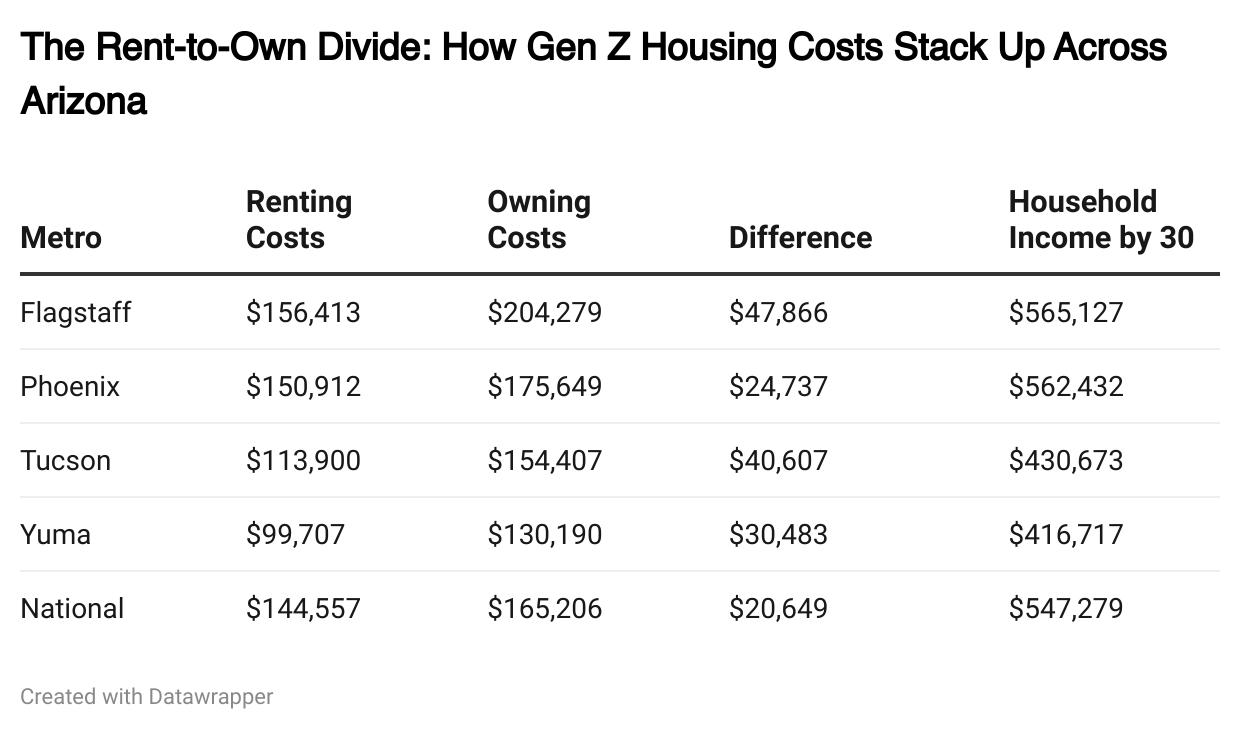
Page : 12

Earning More, Spending More
Smoother Sailing Than the Coasts
On a national scale, Generation Z is on track to earn around $550,000 in their 20s—14% more than what Millennials did at the same age. Yes, their housing costs are higher, but so are their wages. While millennials in Phoenix spent $126,190 on rent in their 20s, Gen Z is projected to shell out $150,912 - a 14% increase. The data shows that renting costs account for 27% of the income from ages 22 to 29, the same percentage for millennials. However, Generation Z's wages are significantly higher, painting a promising financial future.
The situation could be more challenging elsewhere. For instance, Gen Zers in San Jose face a staggering $170,890 gap between renting and owning costs in their 20s. Renting there costs nearly $300,000 before 30, while buying a home (excluding the down payment) can reach $466,000. In Ann Arbor, Generation Z can save $21,400 by purchasing versus renting. The data shows a more favorable housing landscape for Phoenix's Gen Z than other parts of the country. With a comparatively small rent-to-own divide, this digitally native generation may have a smoother path to homeownership in the Valley, providing a sense of security and stability.
Page : 13
Stargazing and Home Values Soar in Fountain Hills
By Jaki Underwood
As the editor-in-chief of Arizona Ascent magazine, I've had a front-row seat to Fountain Hills's transformation over the past few decades. But the town is about to reach new heights—quite literally—with the groundbreaking of the International Dark Sky Discovery Center (IDSDC). This is a unique opportunity for our readers to witness the birth of a landmark that will shape the future of Fountain Hills.
Imagine a $ 25 million, 23,000-square-foot facility, set against the backdrop of a rare solar eclipse on April 8, 2024. This is the International Dark Sky Discovery Center (IDSDC), a game-changer for the local real estate market. Designed by the renowned SWABACK and constructed by McCarthy Building Companies, the IDSDC will house a state-of-the-art 27.5inch PlaneWave telescope, a 65-seat planetarium, and a 150-person multipurpose auditorium.
"What better way to usher in the construction of the International Dark Sky Discovery Center than at such a rare celestial event under the wide-open skies of Fountain Hills? The next such eclipse is another 20 years away," said IDSDC Board President Joe Bill. I hope that by then, the IDSDC will be an Arizona icon known worldwide as a place that enables skywatchers of all ages to learn more about the observable universe."
As a lifelong resident of Fountain Hills, I can attest to the town's unique status as one of only two International Dark Sky Communities near a central metropolitan area. This designation, which we earned back in 2018, has already begun to drive up home prices in the area. According to the latest data, the median home price in Fountain Hills has increased by 27% over the past six years, outpacing the broader Phoenix metro area. With the IDSDC on the horizon, we can expect this trend to continue, bringing excitement to homeowners and potential buyers alike.
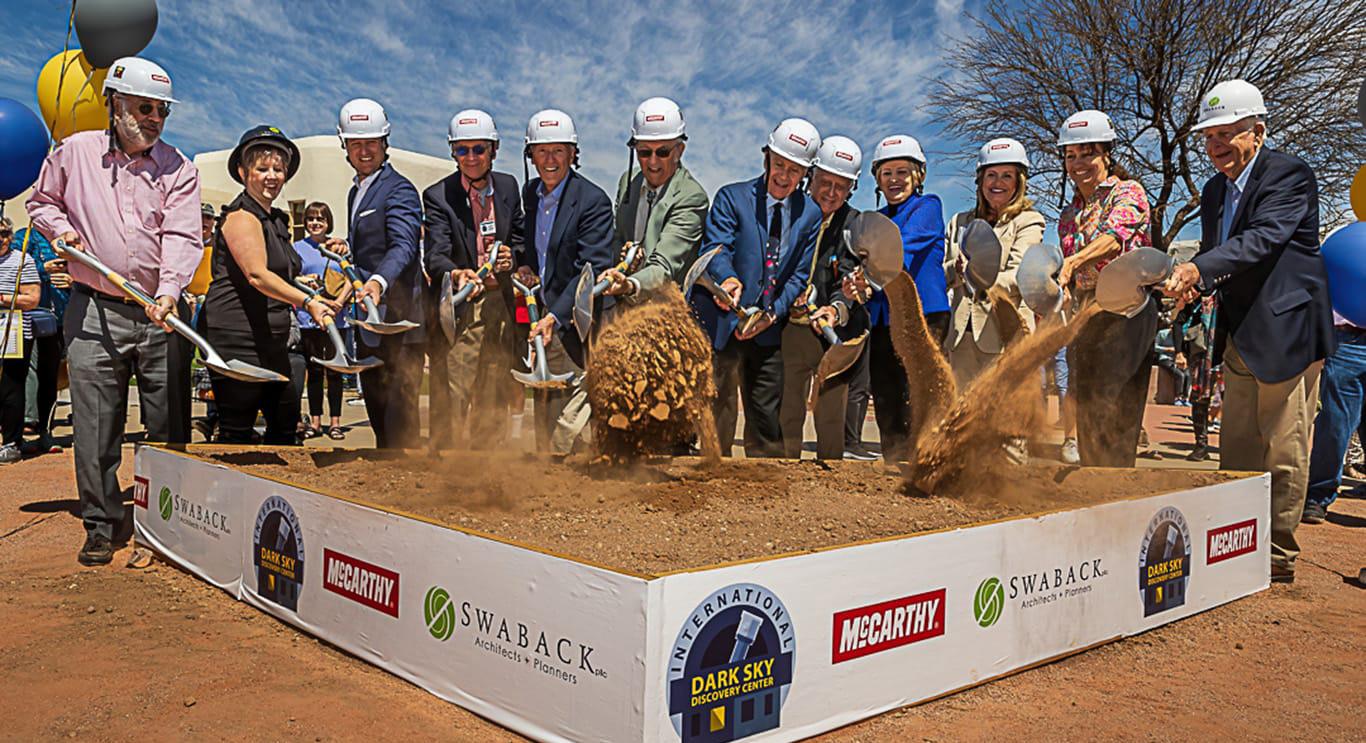
Page : 14
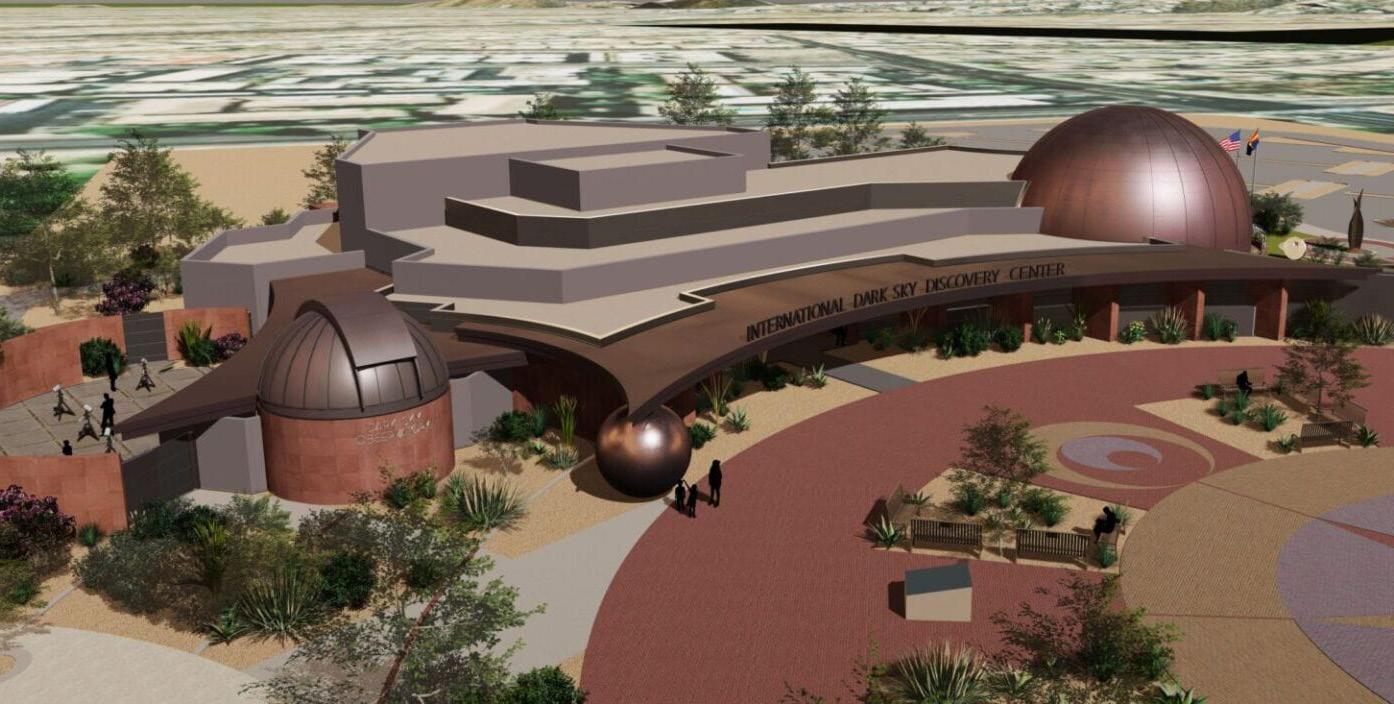
"The IDSDC is going to take that to the next level," I predict. "Not only will it attract more astronomy enthusiasts, but it will shine a spotlight on Fountain Hills as a unique oasis of dark skies and outdoor recreation."
Indeed, having an observatory of this caliber right in our backyard will be a significant selling point for the town. Jon Bernhard, design architect and Partner-in-charge with SWABACK, shares my enthusiasm for the project.
"SWABACK provides design services for exciting projects around the world. As a 34year resident of Fountain Hills, I have a vested interest in this extraordinary facility," said Bernhard. "The Discovery Center provides an exciting and unique recreational and educational amenity in the community for residents and visitors. I look forward to sharing the range of activities and functions with family and friends."
In addition to allowing residents to view parts of the night sky obscured by light pollution elsewhere, the IDSDC will also educate visitors on the importance of dark sky preservation. This aligns perfectly with the environmental consciousness of many modern home buyers. It's a testament to our community's commitment to education and environmental stewardship, something we can all be proud of.
"We're seeing a real shift in priorities, where people are looking for homes that not only meet their needs but also align with their values," I say. "The IDSDC checks a lot of those boxes - it's educational, environmentally conscious, and just a unique amenity that you can't find anywhere else in the region."
With the first research-grade telescope in Greater Phoenix, the IDSDC is poised to become a significant draw for stargazers, students, and families. And for homeowners in Fountain Hills, that translates to a whole new level of curb appeal.
Page : 15
Revolutionizing Cancer Research in the Grand Canyon State: An Interview with Brenda Noggy, Founder of TrialNAV
By Jennifer Conrad
In the fast-paced world of cancer research and clinical trials, one Arizona-based company is working tirelessly, driven by a deep empathy for patients, to eliminate the barriers that prevent them from accessing potentially life-saving therapies. TrialNAV, an oncologyfocused site solutions provider, is revolutionizing how clinical trials are conducted to empower cancer centers and community practices across the Grand Canyon State to increase patient participation and access.
At the helm of this innovative company is Brenda Noggy, the Founder and CEO, a seasoned expert in cancer research and program development. With over 20 years of unwavering dedication and expertise, Noggy has honed her skills in launching and expanding cancer center programs, channeling that expertise into TrialNAV's cutting-edge solutions.
"The biggest problem with clinical trials is the inability to enroll patients," explains Noggy. "While enrollment at academic cancer centers remains around 5-8%, in the community setting, only 1%, even though 80% of oncology patients are seen in those settings. We knew we had to do something to resolve this gap."
Introducing TrialNAV's pioneering product, StaffNAV. This web-based software platform is a game-changer for cancer centers in Arizona, revolutionizing how they manage their trial portfolio and staffing resources. By assessing protocol complexity against staff experience and capacity, StaffNAV equips sites to make informed decisions, ensuring they only open trials they can effectively handle.
"Currently, no software in the US or globally can accurately assess protocol complexity versus workforce capacity," says Noggy. "This analytic data is powerful, allowing research teams to spend less time gathering and analyzing data and more time maintaining protocol compliance, screening, enrolling, and educating patients."
But TrialNAV's impact extends beyond just technology. The company offers a comprehensive suite of services, including clinical trial program development, staffing solutions, and training programs designed to address the unique challenges faced by cancer centers and community practices in Arizona.
"We believe in a 'service as a software' approach," explains Noggy. "We curate our solutions to the trial sites, starting with a baseline review of their operational workflow, culture, resources, and the patients they serve. This allows us to fill gaps in their process, either with our solutions or through carefully vetted vendor partners."
Page : 16

The tangible results of TrialNAV's efforts are already visible in the state. The company has forged partnerships with Banner MD Anderson Cancer Center, Arizona's largest employer, and Yuma Regional Medical Center, a cancer center serving a rural community. These collaborations are already making a difference in the community.
"The ability to streamline the clinical trial operations of these two distinguished cancer research programs in the state will significantly impact the community," says Noggy. "We've also collaborated with a local physician oncology community practice group, providing them with the resources they need to conduct trials in their patient population."
Looking ahead, TrialNAV has set its sights on ambitious yet achievable goals. The company aims to expand its software to assist cancer trial sites across the US, diversify its coverage to include non-oncology trials, and eventually offer its product globally. But beyond these immediate goals, TrialNAV's larger vision is to foster collaboration between community oncology physicians and academic physicians, facilitating the development and implementation of innovative treatment trials.
With a focus on decentralizing early-phase trials and leveraging technology to create a more patient-centric approach, TrialNAV is poised to make a significant impact in Arizona, across the nation, and beyond. As Noggy aptly puts it, "Patients do not have to leave their homes in their limited time, and potentially lose their jobs, just to be in a clinical trial and have access to cutting-edge treatment options. This will significantly impact our patients living in remote, underserved areas."
Page : 17
Thank You to Sponsors
As we end our May issue of Arizona Ascent Magazine, we sincerely thank all our esteemed sponsors. Their unwavering support has been instrumental in bringing this publication and its empowering mission to life.
We sincerely appreciate Jill Wicker from Fidelity National Title, Jennifer Conrad of The Conrad Group, and Jodie Winters from Rocket Mortgage. Their generous contributions have not only enabled us to provide our readers with insightful content and valuable resources, but they have also played a pivotal role in shaping the very essence of our magazine's mission, empowering individuals in the real estate community in Arizona.
As the Editor-in-Chief, I, Jaki Underwood, express my heartfelt appreciation for our sponsors' shared belief in our vision. Through their sponsorship, our partners have demonstrated a steadfast commitment to empowering, educating, and activating individuals within our community, aligning perfectly with our mission.
Empowerment begins with knowledge, and in every issue of our magazine, we strive to provide our readers with insights and tools to help prospective homeowners, investors, and enthusiasts unlock the full potential of their real estate journey in Arizona.
Together, as we embark on this exciting path, we are publishing a magazine and fostering a platform for growth, knowledge-sharing, and community engagement.
Thank you to every one of our sponsors for their vital and irreplaceable role in making Arizona Ascent Magazine a reality. Without their support, our mission to empower the real estate community in Arizona would not be possible.
Jaki Underwood Editor-in-Chief

Page : 18



Named to the Fortune 500 on an annual basis The only Fortune 500 company in its industry Identified by Forbes as a Global 2000 Company Chosen by Forbes as one of The World’s Best Companies Selected by Forbes as one of the Best Managed Companies in America Named by Forbes to the Platinum 400: America’s Best Big Companies 150 years of Title & Escrow Experience Title insurance assures owners that they are acquiring clear title. It is designed to eliminate risk or loss caused by defects in title from the past. Title insurance provides coverage only for title problems which were already in existence at the time the policy was issued. Why Fidelity National Title Agency Why Fidelity National Title Agency What is Title Insurance What is Title Insurance Committed to Providing You Committed to Providing You Exceptional Service Exceptional Service Jill WICKER Jill WICKER FNTArizona.com SALES EXECUTIVE 317-313-7179 Jill.Wicker@fnf.com



















